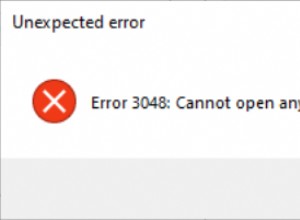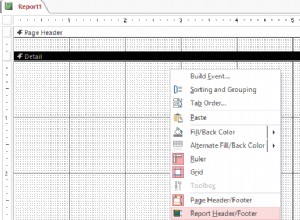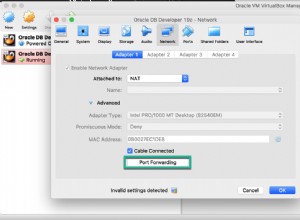मैंने इसका बहुत प्रभावी क्रियान्वयन देखा है जो इस प्रकार है:
TABLE audit_entry (
audit_entry_id INTEGER PRIMARY KEY,
audit_entry_type VARCHAR2(10) NOT NULL,
-- ^^ stores 'INSERT' / 'UPDATE' -- / 'DELETE'
table_name VARCHAR2(30) NOT NULL,
-- ^^ stores the name of the table that is changed
column_name VARCHAR2(30) NOT NULL,
-- ^^ stores the name of the column that is changed
primary_key_id INTEGER NOT NULL,
-- ^^ Primary key ID to identify the row that is changed
-- Below are the actual values that are changed.
-- If the changed column is a foreign key ID then
-- below columns tell you which is new and which is old
old_id INTEGER,
new_id INTEGER,
-- If the changed column is of any other numeric type,
-- store the old and new values here.
-- Modify the precision and scale of NUMBER as per your
-- choice.
old_number NUMBER(18,2),
new_number NUMBER(18,2),
-- If the changed column is of date type, with or without
-- time information, store it here.
old_ts TIMESTAMP,
new_ts TIMESTAMP,
-- If the changed column is of VARCHAR2 type,
-- store it here.
old_varchar VARCHAR2(2000),
new_varchar VARCHAR2(2000),
...
... -- Any other columns to store data of other types,
... -- e.g., blob, xmldata, etc.
...
)
और हम audit_entry_id के लिए हमें नया वृद्धिशील पूर्णांक मान देने के लिए एक सरल अनुक्रम बनाते हैं :
CREATE SEQUENCE audit_entry_id_seq;
audit_entry . जैसी तालिका की सुंदरता यह है कि आप सभी प्रकार के डीएमएल के बारे में जानकारी संग्रहीत कर सकते हैं- INSERT , UPDATE और DELETE उसी स्थान पर।
उदाहरण के लिए, डालने के लिए, old_* . रखें कॉलम शून्य और new_* को पॉप्युलेट करें अपने मूल्यों के साथ।
अपडेट के लिए, old_* दोनों को पॉप्युलेट करें और new_* कॉलम जब भी बदले जाते हैं।
हटाने के लिए, बस old_* को पॉप्युलेट करें कॉलम और new_* रखें शून्य।
और हां, audit_entry_type . के लिए उचित मान दर्ज करें .;0)
फिर, उदाहरण के लिए, आपके पास इस तरह की एक तालिका है:
TABLE emp (
empno INTEGER,
ename VARCHAR2(100) NOT NULL,
date_of_birth DATE,
salary NUMBER(18,2) NOT NULL,
deptno INTEGER -- FOREIGN KEY to, say, department
...
... -- Any other columns that you may fancy.
...
)
बस इस तालिका पर निम्नानुसार एक ट्रिगर बनाएं:
CREATE OR REPLACE TRIGGER emp_rbiud
-- rbiud means Row level, Before Insert, Update, Delete
BEFORE INSERT OR UPDATE OR DELETE
ON emp
REFERENCING NEW AS NEW OLD AS OLD
DECLARE
-- any variable declarations that deem fit.
BEGIN
WHEN INSERTING THEN
-- Of course, you will insert empno.
-- Let's populate other columns.
-- As emp.ename is a not null column,
-- let's insert the audit entry value directly.
INSERT INTO audit_entry(audit_entry_id,
audit_entry_type,
table_name,
column_name,
primary_key,
new_varchar)
VALUES(audit_entry_id_seq.nextval,
'INSERT',
'EMP',
'ENAME',
:new.empno,
:new.ename);
-- Now, as date_of_birth may contain null, we do:
IF :new.date_of_birth IS NOT NULL THEN
INSERT INTO audit_entry(audit_entry_id,
audit_entry_type,
table_name,
column_name,
primary_key,
new_ts)
VALUES(audit_entry_id_seq.nextval,
'INSERT',
'EMP',
'DATE_OF_BIRTH',
:new.empno,
:new.date_of_birth);
END IF;
-- Similarly, code DML statements for auditing other values
-- as per your requirements.
WHEN UPDATING THEN
-- This is a tricky one.
-- You must check which columns have been updated before you
-- hurry into auditing their information.
IF :old.ename != :new.ename THEN
INSERT INTO audit_entry(audit_entry_id,
audit_entry_type,
table_name,
column_name,
primary_key,
old_varchar,
new_varchar)
VALUES(audit_entry_id_seq.nextval,
'INSERT',
'EMP',
'ENAME',
:new.empno,
:old.ename,
:new.ename);
END IF;
-- Code further DML statements in similar fashion for other
-- columns as per your requirement.
WHEN DELETING THEN
-- By now you must have got the idea about how to go about this.
-- ;0)
END;
/
सावधानी के लिए केवल एक शब्द:ऑडिट करने के लिए आप कौन सी टेबल और कॉलम चुनते हैं, इसके साथ चयन करें, क्योंकि वैसे भी, इस तालिका में पंक्तियों की एक बड़ी संख्या होगी। SELECT इस तालिका के विवरण आपकी अपेक्षा से धीमे होंगे।
मैं वास्तव में यहां किसी अन्य प्रकार के कार्यान्वयन को देखना पसंद करूंगा, क्योंकि यह सीखने का एक अच्छा अनुभव होगा। आशा है कि आपके प्रश्न का अधिक उत्तर मिलेगा, क्योंकि यह एक ऑडिट तालिका का सबसे अच्छा कार्यान्वयन है जिसे मैंने देखा है और मैं अभी भी इसे बेहतर बनाने के तरीकों की तलाश कर रहा हूं।




